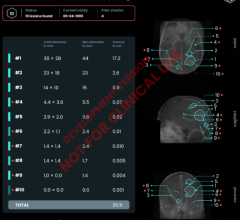February 15, 2010 - New data released shows targeted radiotherapy, using real-time prostate tumor tracking during external beam radiation, enables the delivery of high doses of radiation, while reducing treatment-related side effects, including bowel urgency, rectal irritation and urinary irritation.
The study, which was presented at the 51st annual meeting of the American Society for Therapeutic Radiology and Oncology (ASTRO), November1-4,2009, was significant because radiation for prostate cancer is often delivered without real-time tracking, which can result in the morbidities due to unintended irradiation of healthy tissue. The tumor tracking technology works similar to the GPS system in cars and is installed in more than 90 medical centers nationwide.
The objective of the study was to investigate whether patient-reported quality of life after high-dose external beam intensity-modulated radiotherapy for prostate cancer can be improved by decreasing planning target volume margins while using real-time tumortracking.
In the study, patients underwent radiotherapy with nominal 3-mm margins and electromagnetic real-time tracking. Morbidity was assessed before and at the end of radiotherapy using Expanded Prostate Cancer IndexComposite (EPIC) questionnaires. Changes in scores were compared between the Assessing Impact of Margin Reduction(AIM) study cohort and the comparator PROST-QAcohort, treated with conventional margins.
The authors concluded that prostate cancer patients treated with reduced margins and tumor tracking had less radiotherapy- related morbidity than their counterparts treated with conventional margins. Highlycontoured intensity-modulated radiotherapy shows promise as a successful strategy for reducing morbidity in prostate cancer treatment.
Reference: Sandler, H, et al. Reduction in Patient-reported Acute Morbidity in Prostate Cancer Patients Treated With 81-Gy Intensity-modulated Radiotherapy Using Reduced Planning Target Volume Margins and Electromagnetic Tracking: Assessing the Impact of Margin Reduction Study.


 December 11, 2025
December 11, 2025 









